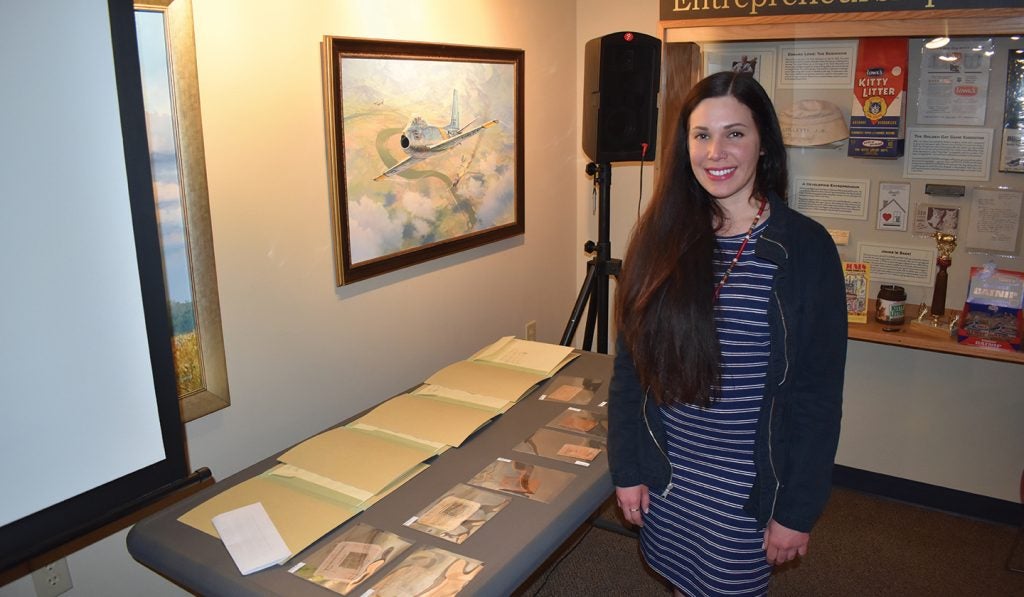Local museum hosts lecture on Birch Bark Booklets of Simon Pokagon
Published 10:49 am Friday, April 5, 2019

- Blaire Topash-Caldwell gave a presentation at the Dowagiac Area History Museum Wednesday. The booklets are made from real birch bark. (Leader photo/ADAM DROSCHA)
DOWAGIAC — With printed history laid out on the table behind her, Blaire Topash-Caldwell waited patiently Wednesday as local history buffs filled the last of the chairs in the Dowagiac Area History Museum’s basement.
Topash-Caldwell, an archivist for the Pokagon Band of the Potawatomi Indians, led the second installment of the museum’s spring lecture series to shine a light on the historical significance of the Birch Bark Booklets by prominent author and tribal leader Simon Pokagon.
Many Dowagiac area locals may be familiar with the name Simon Pokagon, the Potawatomi writer and public figure of the late 19th century. Pokagon was the son of the prominent Potawatomi leader, Leopold Pokagon, but carved his place in history by publishing one of his most famous works, “Queen of the Woods,” as well as writing other works like the provocative “Red Man’s Rebuke,” “Potawatomi Book of Genesis: Legend of the Creation of Man,” “Algonquin Legends of Paw Paw Lake,” and “Algonquin Legends of South Haven,” the latter four which are among his Birch Bark Booklets.
Caldwell’s lecture covered some of Pokagon’s other accolades and claims to fame, but primarily focused on his birch bark booklets, especially “Red Man’s Rebuke,” which was a direct response to the 1893 Chicago World’s Fair.
The 1893 World’s Fair, or the World’s Columbian Exposition as it is commonly referred, was hosted for the 400th anniversary of Christopher Columbus’ arrival to America. Pokagon’s “Red Man’s Rebuke” was a prolific text protesting the World’s Fair by outlining how it ran in direct contrast to the tradition and history of the indigenous peoples of America.
“On behalf of my people, the American Indians, I hereby declare, you the pale-faced race that has usurped our lands and homes, that we have no spirit to celebrate with you the great Columbian Fair now being held in the Chicago city, the wonder of the world,” Pokagon wrote.
“For 1893 that was pretty radical,” Caldwell said after reading Pokagon’s words. “[‘Red Man’s Rebuke’] is not much longer after removal, after reservation systems, and at this point, most native Americans aren’t actually U.S. citizens, so the lack of power there and political ramifications, I think, is pretty substantial.”
Caldwell expounded on the text’s implications at the time and how its message still resonates with indigenous peoples today. She spoke about the heritage, history and lore of Pokagon’s other birch bark texts and how they are still revered among the Potawatomi. Caldwell also talked about the uniqueness of Pokagon’s use of birch bark for his texts, which was a social statement in itself.
“A lot of people know about Simon Pokagon because of the book he authored, ‘Queen of the Woods,’” said Steve Arseneau, the director of DAHM. “There’s a lot of interest in him and what he was doing as a Potawatomi person of the late 1800s.”
Arseneau saw a previous lecture Caldwell gave on Simon Pokagon, which inspired him to choose her for a future DAHM spring lecture series.
“I think Blaire did a great job,” Arseneau said. “I think it’s great the Pokagon band has this collection.”
The next lecture in the Dowagiac Area History Museum’s Spring Lecture Series will be at 6:30 p.m. Wednesday, May 1. The lecture will be hosted by Don Lyons and discuss the Heddon Museum.






